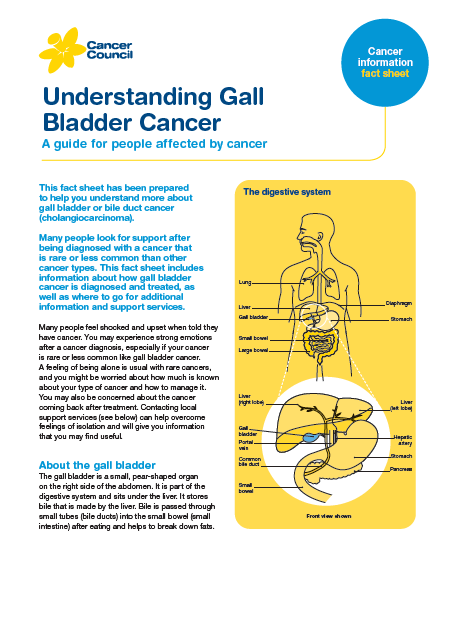- Home
- Gall bladder cancer
- Diagnosis
Gall bladder diagnosis
If your doctor thinks that you may have gall bladder cancer, they will perform a physical examination and carry out certain tests. If the results suggest that you may have gall bladder cancer, your doctor will refer you to a specialist who will carry out more tests.
These tests may include:
| Blood tests | Including a full blood count (to measure your white blood cells, red blood cells, platelets), liver function tests (to measure chemicals that are found or made in your liver) and tumour markers (to measure chemicals produced by cancer cells). |
| Ultrasound scan | Soundwaves are used to create pictures of the inside of your body. For this scan, you will lie down and a gel will be spread over the affected part of your body. A small device called a transducer is moved over the area by an ultrasound radiographer. The transducer sends out soundwaves that echo when they encounter something dense, like an organ or tumour. The ultrasound images are then projected onto a computer screen. An ultrasound is painless and takes about 15–20 minutes. |
| CT (computerised tomography) and/or MRI (magnetic resonance imaging) scans | Special machines are used to scan and create pictures of the inside of your body. Before the scan you may have an injection of dye (called contrast) into one of your veins, which makes the pictures clearer. During the scan, you will need to lie still on an examination table. For a CT scan the table moves in and out of the scanner which is large and round like a doughnut; the scan itself usually takes about 10–30 minutes. For an MRI scan the table slides into a large metal tube that is open at both ends; the scan takes a little longer, about 30–90 minutes to perform. Both scans are painless. |
| Diagnostic laparoscopy | A thin tube with a camera on the end (laparoscope) is inserted under sedation into the abdomen so the doctor can view inside. |
| Cholangiography | An x-ray of the bile duct to see if there is any narrowing or blockage and help plan surgery to remove the gall bladder. For an endoscopic retrograde cholangiopancreatography (ERCP), the doctor inserts a flexible tube with a camera on the end (endoscope) down your throat into your small intestine while you are sedated to view your gut and take images. |
| Biopsy | Removal of some tissue from the affected area for examination under a microscope. In the gall bladder, a biopsy may be done during a laparoscopy or cholangiography. Otherwise a needle biopsy is done, where a local anaesthetic is used to numb the area, then a thin needle is inserted into the tumour under ultrasound or CT guidance. |
Finding a specialist
Rare Cancers Australia have a directory of health professionals and cancer services across Australia.
→ READ MORE: Gall bladder treatment
Podcast: Tests and Cancer
Listen to more episodes of our podcast for people affected by cancer
Kathleen Boys, Consumer; Dr Julian Choi, HPB Surgeon, Western Health and Epworth Hospital, Vic; David Fry, Consumer; Dr Robert Gandy, Hepatobiliary Surgeon, Prince of Wales Hospital, Randwick, NSW; Yvonne King 13 11 20 Consultant, Cancer Council NSW; Elizabeth Lynch, Consumer; Dr Jenny Shannon, Medical Oncologist, Nepean Hospital Cancer Centre, NSW.
View the Cancer Council NSW editorial policy.
